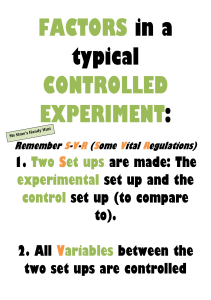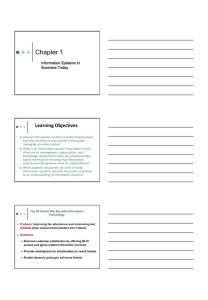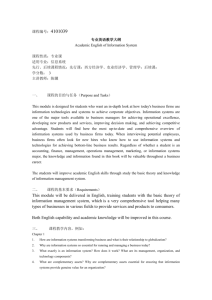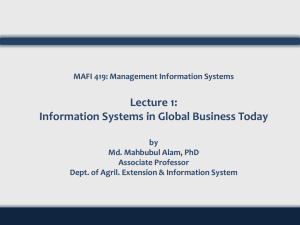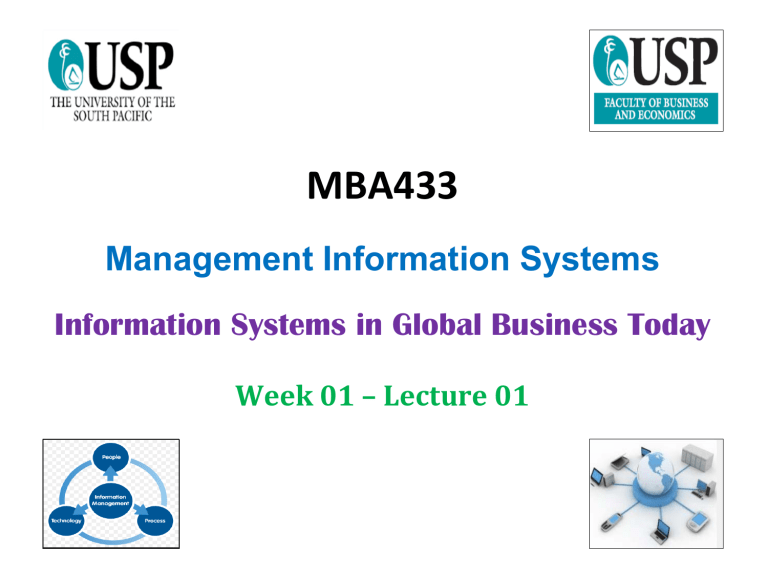
MBA433 Management Information Systems Information Systems in Global Business Today Week 01 – Lecture 01 Today’s Session Agenda: 1. Short Video Clip = 5 Minutes 2. The Course Outline = 10 Minutes 3. Lecture 01: IS in Global Business = 45 minutes 4. Break = 5 Minutes 5. Tutorial = 20 Minutes 6. Lecture 02: Understanding MIS = 45 Minutes 7. Break = 5 Minutes 8. Case Study = 20 Minutes 9. Video = 5 Minutes 10. Practical Lab = 60 Minutes Why Are We Here Today? Video on Did You Know (2019) … The Course Outline … Session Structure: 1.5 lecture + 1.5 activities + 1 lab … Email only to sam.goundar@gmail.com No Moodle Message, No Phone Calls … Last 30-45 minutes – individual/group consultation … Intensive course … assessment each session … One Saturday missed = 20% of the course missed ... Any Questions from the Course Outline … Use of Videos in the Course … Visual learners … Different perspectives on the same topic … First Session Any Questions from the Course Outline … … … … … … Any Questions about the Course in General … Slide 6 of 00 Course Announcements Assessments later … … … … … … Any announcement from the students … Chapter 1 Information Systems in Business Today Learning Objectives 1.1 How are information systems transforming business, and why are they so essential for running and managing a business today? 1.2 What is an information system? How does it work? What are its management, organization, and technology components? Why are complementary assets essential for ensuring that information systems provide genuine value for organizations? 1.3 What academic disciplines are used to study information systems, and how does each contribute to an understanding of information systems? How Information Systems Are Transforming Business – Mobile digital platform – Systems used to improve customer experience, respond to customer demand, reduce inventories, and more – Growing online newspaper readership – Expanding e-commerce and Internet advertising – New security and accounting laws Figure 1.1 Information Technology Capital Investment What’s New in Management Information Systems (1 of 2) • Technology – Cloud computing – Big data and the Internet of Things (IoT) – Mobile digital platform • Management – Online collaboration and social networking software – Business intelligence – Virtual meetings What’s New in Management Information Systems (2 of 2) • Organizations – Social business – Telework – Co-creation of business value (SCM example) Interactive Session: Management: The Mobile Pocket Office (1 of 2) • Class Discussion • What kinds of applications are described here? What business functions do they support? How do they improve operational efficiency and decision making? • Identify the problems that businesses in this case study solved by using mobile digital devices. Interactive Session: Management: The Mobile Pocket Office (2 of 2) • What kinds of businesses are most likely to benefit from equipping their employees with mobile digital devices such as iPhones and iPads? • One company deploying iPhones has said, “The iPhone is not a game changer, it's an industry changer. It changes the way that you can interact with your customers” and “with your suppliers.” Discuss the implications of this statement. Globalization Challenges and Opportunities: A Flattened World • Internet has drastically reduced costs of operating on global scale • Increases in foreign trade, outsourcing • Presents both challenges and opportunities The Emerging Digital Firm • In a fully digital firm: – Significant business relationships are digitally enabled and mediated – Core business processes are accomplished through digital networks – Key corporate assets are managed digitally • Digital firms offer greater flexibility in organization and management – Time shifting, space shifting Strategic Business Objectives of Information Systems (1 of 2) • Growing interdependence between: – Ability to use information technology and – Ability to implement corporate strategies and achieve corporate goals • IS for Competitive Advantage … Strategic Business Objectives of Information Systems (2 of 2) • Firms invest heavily in information systems to achieve six strategic business objectives: 1. Operational excellence 2. New products, services, and business models 3. Customer and supplier intimacy 4. Improved decision making 5. Competitive advantage 6. Survival Figure 1.2 The Interdependence Between Organizations and Information Systems Operational Intelligence • Improvement of efficiency to attain higher profitability • Information systems, technology an important tool in achieving greater efficiency and productivity • Supermarket Re-Order Systems … (SCM example with JIT) New Products, Services, and Business Models • Business model: describes how company produces, delivers, and sells product or service to create wealth • Information systems and technology a major enabling tool for new products, services, business models – Examples: Apple’s iPad, Google’s Android OS, and Netflix Customer and Supplier Intimacy • Serving customers well leads them to return, increasing revenue and profits – Example: High-end hotels that use computers to track customer preferences and then monitor and customize the environment • Intimacy with suppliers allows them to provide vital inputs, which lowers costs – Example: Information system which links sales records to contract manufacturer on how much to produce … Improved Decision Making • Without accurate information: – Managers must use forecasts, best guesses, luck – Results in: ▪ Overproduction, underproduction ▪ Misallocation of resources ▪ Poor response times – Poor outcomes raise costs, lose customers • Example: Verizon’s web-based digital dashboard to provide managers with real-time data on customer complaints, network performance, line outages, and so on Competitive Advantage • Delivering better performance • Charging less for superior products • Responding to customers and suppliers in real time • Examples: Apple, Walmart, UPS Survival • Information technologies as necessity of business • Industry-level changes – Example: Bank’s introduction of A T M s/Online Banking (Customers = Workers) • Governmental regulations requiring record-keeping – Examples: FRCA – Inland Revenue – Linking everything with your TIN What is an Information System? (1 of 3) • Information system – Set of interrelated components – Collect, process, store, and distribute information – Support decision making, coordination, and control • Information vs. data – Data are streams of raw facts – Information is data shaped into meaningful form Figure 1.3 Data and Information What is an Information System? (2 of 3) • Three activities of information systems produce information organizations need – Input: Captures raw data from organization or external environment – Processing: Converts raw data into meaningful form – Output: Transfers processed information to people or activities that use it What is an Information System? (3 of 3) • Feedback – Output is returned to appropriate members of organization to help evaluate or correct input stage • Computer/computer program vs. information system – Computers and software are technical foundation and tools, similar to the material and tools used to build a house Figure 1.4 Functions of an Information System Dimensions of Information Systems • Organizations • Management • Technology Figure 1.5 Information Systems Are More Than Computers Dimensions of Information Systems: Organizations (1 of 2) • Hierarchy of authority, responsibility – Senior management – Middle management – Operational management – Knowledge workers – Data workers – Production or service workers Figure 1.6 Levels in a Firm Dimensions of Information Systems: Organizations (2 of 2) • Separation of business functions – Sales and marketing – Human resources – Finance and accounting – Manufacturing and production • Unique business processes • Unique business culture • Organizational politics Dimensions of Information Systems: Management • Managers set organizational strategy for responding to business challenges • In addition, managers must act creatively – Creation of new products and services – Occasionally re-creating the organization Dimensions of Information Systems: Technology • Computer hardware and software • Data management technology • Networking and telecommunications technology – Networks, the Internet, intranets and extranets, World Wide Web • IT infrastructure: provides platform that system is built on Interactive Session: Technology: UPS Competes Globally with Information Technology • Class Discussion – What are the inputs, processing, and outputs of UPS’s package tracking system? – What technologies are used by UPS? How are these technologies related to UPS’s business strategy? – What strategic business objectives do UPS's information systems address? – What would happen if UPS’s information systems were not available? Dimensions of UPS Tracking System • Organizational – Procedures for tracking packages and managing inventory and provide information • Management – Monitoring service levels and costs • Technology – Handheld computers, bar-code scanners, networks, desktop computers, and so on It Isn’t Just Technology: A Business Perspective on Information Systems (1 of 3) • Information system is instrument for creating value • Investments in information technology will result in superior returns – Productivity increases – Revenue increases – Superior long-term strategic positioning It Isn’t Just Technology: A Business Perspective on Information Systems (2 of 3) • Business information value chain – Raw data acquired and transformed through stages that add value to that information – Value of information system determined in part by extent to which it leads to better decisions, greater efficiency, and higher profits • Business perspective – Calls attention to organizational and managerial nature of information systems It Isn’t Just Technology: A Business Perspective on Information Systems (3 of 3) • Investing in information technology does not guarantee good returns • There is considerable variation in the returns firms receive from systems investments • Factors – Adopting the right business model – Investing in complementary assets (organizational and management capital) Figure 1.7 The Business Information Value Chain Figure 1.8 Variation in Returns on Information Technology Complementary Assets: Organizational Capital and the Right Business Model (1 of 2) • Assets required to derive value from a primary investment • Firms supporting technology investments with investment in complementary assets receive superior returns • Example: Invest in technology and the people to make it work properly Complementary Assets: Organizational Capital and the Right Business Model (2 of 2) • Complementary assets – Examples of organizational assets ▪ Appropriate business model ▪ Efficient business processes – Examples of managerial assets ▪ Incentives for management innovation ▪ Teamwork and collaborative work environments – Examples of social assets ▪ The Internet and telecommunications infrastructure ▪ Technology standards Figure 1.9 Contemporary Approaches to Information Systems Technical Approach • Emphasizes mathematically based models • Computer science, management science, operations research Behavioral Approach • Behavioral issues (strategic business integration, implementation, etc.) • Psychology, economics, sociology Approach of This Text: Sociotechnical Systems (1 of 2) • Management information systems – Combines computer science, management science, operations research, and practical orientation with behavioral issues • Four main actors – Suppliers of hardware and software – Business firms – Managers and employees – Firm’s environment (legal, social, cultural context) Approach of This Text: Sociotechnical Systems (2 of 2) • Sociotechnical view – Optimal organizational performance achieved by jointly optimizing both social and technical systems used in production – Helps avoid purely technological approach Figure 1.10 A Sociotechnical Perspective on Information Systems Copyright
